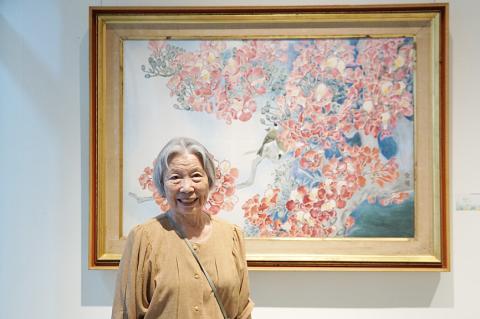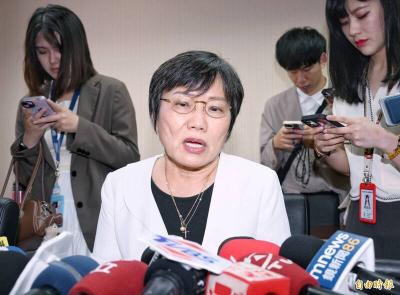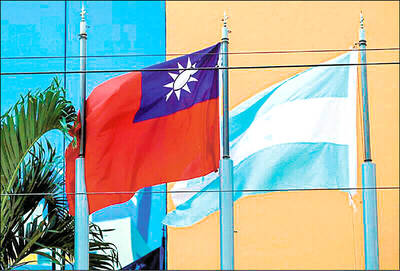Lin Hsing-hua (林星華) is one of the nation’s new female artists whose expertise is Eastern gouache painting.
A student of artist Lin Chih-chu (林之助) — dubbed the father of Eastern gouache painting in Taiwan — Lin Hsing-hua said she swore to him that she would never give up the style after Lin Chih-chu told her that his female students tended to quit.
Born in Taichung in 1932, Lin Hsing-hua did not take art lessons as a child, but learned how to make clothes at Taichung Home Economics and Commercial High School.

Photo: Ho Tsung-han, Taipei Times
She impressed her teachers by being able to draw near-perfect lines freehand, to the point where one teacher asked her to make a suit for a child.
At the National Taichung University of Education, Lin Hsing-hua became Lin Chih-chu’s student.
Lin Hsing-hua said that he first taught her how sketch and paint in watercolors, but noting her special interest in painting, he began tutoring her on the basics of Eastern gouache painting — including how to prepare the paper, sketch and apply color — outside of class.
Eastern gouache painting was introduced to Taiwan during the Japanese colonial period and is often referred to as nihonga, a Japanese painting style, to distinguish it from Western styles.
The paint is made by mixing glue with pigments made of minerals, soil, metals or other materials.
“The beauty of Eastern gouache lies in its color,” Lin Hsing-hua said, adding that it does not fade.
“Once it is painted, it is preserved forever,” she said.
Her oldest brother would mail her pigments from Tokyo, where he worked, she said, adding that he would spend thousands of New Taiwan dollars on each package.
The post office mistook one such package for drugs and would not let her take it, she said.
It was powdered oyster shells — a relatively inexpensive pigment-making material, she said.
Lin Hsing-hua said that Lin Chih-chu cared greatly about painting real-life objects, teaching her to pay attention to details such as the direction in which a morning glory plant was growing.
An artist must be familiar with the structure and characteristics of the subject they are painting, be it a flower or a bird, otherwise, an expert could easily spot mistakes, she said.
To paint birds properly, Lin Hsing-hua said she kept pet birds — including a pheasant — to observe their wings and feet.
The Lin Chih-chu Memorial museum near the Willow River (柳川) in Taichung is where she learned to paint.
While a junior at the university, her Red Multiflora Rose was selected to be displayed in the now-defunct Taiwan Provincial Fine Arts Exhibition.
She received awards at that exhibition, the Taiwan Provincial Employees’ and Teachers’ Art Exhibition and the Taiyang Art Exhibition.
Unfortunately, her winning works stayed with the organizers, she said, adding that their whereabouts are unknown.
Lin Chih-chu trusted her, she said, adding that while he asked to see the drafts of other students’ work multiple times throughout the creative process, she only showed him her works after they had been exhibited, as she was afraid that her work would become too similar to his.
Lin Chih-chu’s wife took great care of her, often asking her to stay for dinner after class, she said.
When Lin Chih-chu founded the Taiwan Gluepainting Association in 1983, she served as a member of the supervisory committee.
During the Martial Law era, accomplished students were required to join the Chinese Nationalist Party (KMT), she said.
Her younger brother Lin Hsin-chih (林心智) pursued a doctoral degree in child psychology at the University of Georgia in the US, but after he completed his studies, the KMT would not allow him to return to Taiwan because he was not a member of the party, she said, adding that he was not allowed to return even when their mother passed away.
Lin Hung-hsuan (林弘宣), her other younger brother, who was the executive secretary of Formosa Magazine’s (美麗島雜誌) service center, was jailed on Green Island (綠島) for many years following the Kaohsiung Incident, she said, adding that he was not released until he was diagnosed with lymphoma.
The Kaohsiung Incident, also known as the Formosa Incident, took place on Dec. 10, 1979, when the then-KMT government cracked down and imprisoned participants in an anti-government parade organized by the magazine.
For herself, she said most of her abstract paintings were created during the Martial Law era, but added that as the paintings could be interpreted according to each person’s taste, she avoided trouble.
For example, a painting titled Work Hard (打拚) on the surface represented the labor of the people, when in fact it had a hidden message that people were trapped, she said.

Chinese Nationalist Party (KMT) Chairman Eric Chu (朱立倫), spokeswoman Yang Chih-yu (楊智伃) and Legislator Hsieh Lung-chieh (謝龍介) would be summoned by police for questioning for leading an illegal assembly on Thursday evening last week, Minister of the Interior Liu Shyh-fang (劉世芳) said today. The three KMT officials led an assembly outside the Taipei City Prosecutors’ Office, a restricted area where public assembly is not allowed, protesting the questioning of several KMT staff and searches of KMT headquarters and offices in a recall petition forgery case. Chu, Yang and Hsieh are all suspected of contravening the Assembly and Parade Act (集會遊行法) by holding

PRAISE: Japanese visitor Takashi Kubota said the Taiwanese temple architecture images showcased in the AI Art Gallery were the most impressive displays he saw Taiwan does not have an official pavilion at the World Expo in Osaka, Japan, because of its diplomatic predicament, but the government-backed Tech World pavilion is drawing interest with its unique recreations of works by Taiwanese artists. The pavilion features an artificial intelligence (AI)-based art gallery showcasing works of famous Taiwanese artists from the Japanese colonial period using innovative technologies. Among its main simulated displays are Eastern gouache paintings by Chen Chin (陳進), Lin Yu-shan (林玉山) and Kuo Hsueh-hu (郭雪湖), who were the three young Taiwanese painters selected for the East Asian Painting exhibition in 1927. Gouache is a water-based

Taiwan would welcome the return of Honduras as a diplomatic ally if its next president decides to make such a move, Minister of Foreign Affairs Lin Chia-lung (林佳龍) said yesterday. “Of course, we would welcome Honduras if they want to restore diplomatic ties with Taiwan after their elections,” Lin said at a meeting of the legislature’s Foreign Affairs and National Defense Committee, when asked to comment on statements made by two of the three Honduran presidential candidates during the presidential campaign in the Central American country. Taiwan is paying close attention to the region as a whole in the wake of a

OFF-TARGET: More than 30,000 participants were expected to take part in the Games next month, but only 6,550 foreign and 19,400 Taiwanese athletes have registered Taipei city councilors yesterday blasted the organizers of next month’s World Masters Games over sudden timetable and venue changes, which they said have caused thousands of participants to back out of the international sporting event, among other organizational issues. They also cited visa delays and political interference by China as reasons many foreign athletes are requesting refunds for the event, to be held from May 17 to 30. Jointly organized by the Taipei and New Taipei City governments, the games have been rocked by numerous controversies since preparations began in 2020. Taipei City Councilor Lin Yen-feng (林延鳳) said yesterday that new measures by